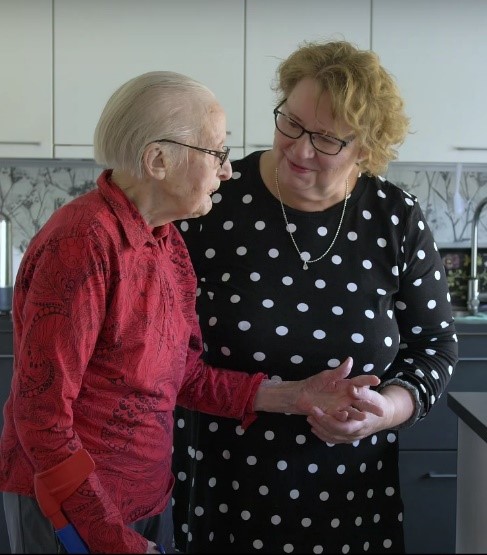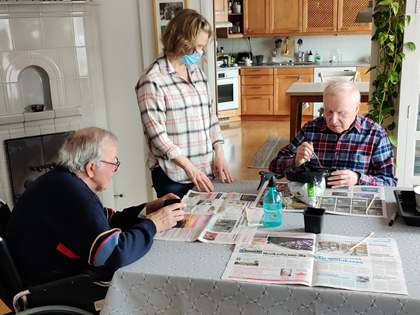Adult Foster Care of Older People Supports Ageing in Place
Sanna Kosonen & Raija Kuisma
Ageing in place means, that older people can continue to live in their own home until the end of their lives. We have to realise that it is possible, even when we grow old. We need to think carefully how to make it possible, and what is the best way to enhance the quality of life, health and wellbeing of older people and at the same time create new ways of working that are sustainable and economical. There are many ways to make it happen e.g., family foster care of older people, older peoples community/ commune, renovation of housing to be more suitable for older people, combination of different kinds of housing and new services. We have to understand that older adults are valuable part of our community and there must be opportunities and choices to live their later life in the environment they prefer to.
Where are we in the northern countries in the issue of ageing in place?
In this article, we look at ageing in place with brief examples in the four northern countries, Sweden, Norway, Denmark and Finland. Then we discuss briefly about a new way of providing homelike environment for older people “Family Foster Care”.
In Finland, family care for older people has proven in many ways to be a form of care that to supports the living and functional capacity of older people. Family care also supports the accessibility of services in the less populated regions of the Nordic countries and provides a livelihood, enabling older or partially able people to find employment in meaningful age-friendly care tasks. The Finnish Family Care Association has received interest from other Nordic countries about sharing knowledge and skills of the family care with support and education systems for older people.

Photo: Sanna Kosonen
Examples in Sweden
Priority in Swedish policies in older peoples’ housing and healthcare is, that older people can live independent lives in their own homes. Municipality has to offer preventative services and help make homes safe. Home help services are offered, but not all older people can get what they need. Older people own altogether 800 000 homes but care options between home care and institutional care are limited. Voluntary and family care is a growing trend. Safe homes are now a new solution. (Välikangas 2009.)
“Vigs Ängar “has offered living and care services for older adults in Köpingebro. since 1995. The municipality helps those who need support and, for example, provide a safety phone for all who need it, and transport to rehabilitation. (Förenade care 2021.)
“Färdknäppen” in Stockholm is the first communal house for older adults. It was founded in 1993 and offers 43 apartments for rent. People who live there, have a communal garden, kitchen, living room and the residents look after the communal areas themselves together. It is open for people over 40 years old, so the age span is wide and provides intergenerational community. (Kollektivhuset Färdknäppen 2021.)
Examples in Norway
Priority in Norway is that older adults can live in their own home as long as possible. Municipality offers many different services to every kind of homes. Home care is first care system that old people can have. Nurses by days and homecare by nights is provided, if needed. If older person cannot live in her/his own home, there are care homes and communal houses to move into. In the nursing homes nurses are on duty 24 hours. (Välikangas 2009.)
Examples in Denmark
Living in social care areas is popular way for older adults in Denmark. Those areas have apartments, care homes, group homes and serviced houses for older people. You can live in there whether you are independent or you need care and you can live there rest of your life. When an older person cannot live on their own anymore, they can choose how and where they want to live. This is important in Denmark.
Service centre for older people in Ærtebjerghaven was built in 2005. There are five living units and 47 apartments. It is built so that its safe, warm, beautiful and works well even for people with memory disorders. There is enough social space where everyone can be together and a big garden and windows where you can see nature. (Plejehjemsoversigten 2021.)
Examples in Finland
In Finland we have many rural areas with limited or no services. Homecare is a big part of services to cater for older peoples’ needs, but it does not reach all who need it. Informal and family carers take care about 160 000 people in Finland. There are many nursing, care and serviced homes, but services between home care and institutional care are lacking.
Family foster care is one solution in Finland
Family foster care at a private home, either at family carer’s home or at older person’s own home, is a new way of living for older people. It can be a full time or part-time, ”day care”. It can be long-term care, when the older person lives permanently with the foster family, or it can be short-term: e.g. during the caregiver’s days off, which is by law 3 days / month) (Perhehoitoliitto 2021).

Figure 1. Foster Carers’ pre-training and Support Model in North Karelia (Kiteen evankelinen kansanopisto, Sanna Kosonen)
Training of family carers?
Family Foster carers receive three months training in North Karelian Civic College in Kitee, where the trainers attend five week-ends for training. They also complete relevant tasks independently and familiarise themselves with the foster homes. The aim of the training is to prepare the foster family to care for an older person, with sufficient information and guidance about different aspects and duties of being a Foster family. Based on that training, foster carers can then then make an informed decision, whether to take up the position as a foster family (Perhehoitoliitto 2021).
Adult foster carer –Competencies
The foster carer is expected to take care of all aspect of the welfare of older people, help and support older person to use her/his own resources and maintain and promote functional ability. They are also trained to enable and support the relations between the older person and his/her close people, co-ordinate all matters of the older persons’ life. They have to have readiness to commit to a family foster carer role. (Perhehoitoliitto 2021.)
During the home training visits, the trainers discuss and evaluate with the foster family several times to ensure sure, that that the foster home is suitable for an older person to live in. The foster family learns first aid skills and also about older peoples’ life and diseases and other important information. When an older person starts foster living, the family gets support from trainers and the municipality.(Sanna Kosonen, 2021)
The family foster care started in 2010 and is still new in Finland. Last year there were 140 000 foster care days (24 hours) in homes in Finland. This is growing fast, and it has so far found to be needed and a good model and we have many older people who need some support to live in a private regular home. This might be a good model for other countries, but it may need some evaluation both from the foster care family’s and also the older person’s perspective. To develop it further we also need more foster cares and the whole concepts needs to be made more known to older people and those who organise the care of older people. (PerhEke-project 2021)

Photo: Joni Mikkonen
What do we have in common Northern countries?
The population in all the Northern countries, as well as in the whole world, is ageing and we have more older people than ever before, and this trend continues. The people live longer and therefore there is already more older adults who need physical and social support. Due to the family structure, older people are often lonely, and here in the sparsely populated North Karelia this is an important factor to consider when planning services for older people. We need to create innovative and diverse living opportunities and care models to meet those needs. Children’s foster care is well known practice in many countries, but family foster care for older people is a new model, that has not been developed yet. In the Northern countries health and social care systems are very similar and the cultures are also close to each other, and therefore trialling family foster care and developing it together in the Northern countries, seems feasible.
Authors:
Sanna Kosonen, project coordinator in PerhEke project & coordinator of adult foster care education and support in North Karelia, Evangelical Folk High School of Kitee.
Raija Kuisma, principal Lecturer, Karelia University of Applied Sciences.
Cover photo: Arja Koponen
Refrences:
Förenade care. www.forenadecare.com.
Kiteen Ev. Kansanopisto, Perhehoidon koulutuksen ja tuen malli. www.kiteenkansanopisto.fi
Kollektivhuset Färdknäppen. 2021. https://fardknappen.se/
Kosonen, S. 2019. Ikäihmisten perhehoidon valmennusmalli. Kiteen evankelinen kansainopistossa. Julkaisematon.
Kuukkanen, M. 2021. NOFCA: Adult foster care of older people. Power point-esitys. Julkaisematon.
Nordic Health and Welfare Statistics. Knowledge and numbers on Health and Social Protection in the Nordic countries. https://nhwstat.org/
Nordic Welfare Centre. 2020. Combating social isolation and in the Nordic countries. Webinar. 20.11.2021. https://www.youtube.com/watch?v=xc6P42oqY3g
Perhehoitoliitto. 2021. Hyvää perhehoitoa. Toimeksiantosuhteisen perhehoidon tietopaketti. Jyväskylä: Perhehoitoliitto.
Perhehoitoliitto. www.perhehoitoliitto.fi
PerhEke-hanke.2021. www.facebook.com
PerhEke-hanke. 2021. Ikäihmisten perhehoitoa: www.youtube.com
Plejehjemsoversigten. 2021. https://plejehjemsoversigten.dk/da/Syddanmark/ODENSE-KOMMUNE/Plejecenter-Aertebjerghaven#
Pohjoismainen hyvinvointikeskus: Aktiivinen ja terve ikääntyminen Pohjoismaissa-hanke. https://nordicwelfare.org/fi/projekt/aktiivinen-terve-ikaantyminen-pohjoismaissa/
Uppsala hemvård. https://www.forenadecare.com/vi-erbjuder/hemtjanst/hemtjanst-uppsala.
Välikangas, K. 2009. Yhteisöllisyyttä, laatua ja vaihtoehtoja Ikääntyneiden välimuotoisen asumisen ratkaisuja Ruotsissa, Norjassa, Tanskassa ja Hollannissa. https://helda.helsinki.fi/bitstream/handle/10138/38038/SY13_2009_Yhteisollisyytta%2c_laatua_ja_vaihtoehtoja.pdf?sequence=1&isAllowed=y accessed 1.10.2021.
